 |
||||||||||||||||||||||||||||||||||||||||||||||||||||||||||||||||||||||||||||||||||||||||||||||||||||||||||||||||||||||||||||||||||||||||||||||||||||||||||||||||||||||||||||||||||||||||||||||||||||||||||||||||||||||||||||||||||||||||||||||||||||||||||||||||||||||||||||||||||||||||||||||||||||||||||||||||||||||||||||||||||||||||||||||||||||||||||||||||||||||||||||||||||||||||||||||||||||||||||||||||||||||||||||||||||||||||||||
| Main -> Separating systems -> Filtration -> Syringe filters, filter holders | ||||||||||||||||||||||||||||||||||||||||||||||||||||||||||||||||||||||||||||||||||||||||||||||||||||||||||||||||||||||||||||||||||||||||||||||||||||||||||||||||||||||||||||||||||||||||||||||||||||||||||||||||||||||||||||||||||||||||||||||||||||||||||||||||||||||||||||||||||||||||||||||||||||||||||||||||||||||||||||||||||||||||||||||||||||||||||||||||||||||||||||||||||||||||||||||||||||||||||||||||||||||||||||||||||||||||||||
| Syringe Filter, DIA-Nielsen | ||||||||||||||||||||||||||||||||||||||||||||||||||||||||||||||||||||||||||||||||||||||||||||||||||||||||||||||||||||||||||||||||||||||||||||||||||||||||||||||||||||||||||||||||||||||||||||||||||||||||||||||||||||||||||||||||||||||||||||||||||||||||||||||||||||||||||||||||||||||||||||||||||||||||||||||||||||||||||||||||||||||||||||||||||||||||||||||||||||||||||||||||||||||||||||||||||||||||||||||||||||||||||||||||||||||||||||
| 1 Syringe Filters DIAFIL CA
The cellulose acetate membrane is hydrophilic. Due to its low protein adsorption, filters with this membrane are frequently used for biological samples (e.g. enzyme solutions, biological macro-molecules). Other applications include the clear filtration and sterile filtration of aqueous solutions. The membrane also has high temperature stability.
2 Syringe Filters DIAFIL RC The regenerated cellulose membrane is, due to its low, unspecific adsorption characteristics for proteins, very suitable for biological solutions. Another range of applications lies, e.g. in the clearing and degassing of eluents for HPLC (Bubble point by request, depending on the type of membrane).
3 Syringe Filters DIAFIL PA The polyamide (nylon) membrane is designed for the filtration of HPLC and GC solutions, but may also be utilized for the clearing and sterilization of alkaline solutions.
4 Syringe Filters DIAFIL PTFE This polytetrafluorethylene membrane can be used for the filtration of aggressive chemicals, including acids and non-aqueous solutions, as well as for GC and HPLC sample preparation. Due to its low flow resistance relative to gases, the membrane is suitable for air and gas filtration operations (ventilation and degassing jobs).
5 Syringe Filters DIAFIL PVDF The Polyvinylidenefluoride membrane is often used for preparation of HPLC samples or for pharmaceutical applications. It has slight hydrophobic properties and can be used for clear filtration of partly organic or organic solvents. Because of its chemical compatibility it is less suitable for the filtration of aggressive media like strong acids, bases and ketones.
6 Syringe Filters DIAFIL GF The glass fiber fleece is suitable for pre-filtration or for operations with hard to filter substances. Due to its three-dimensional filtration surface it possesses a higher absorption capacity for contaminating particles. The glass fiber is inert against solvents, acids and bases.
The pictures to the right show product examples of the different filter types. | 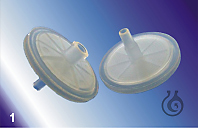 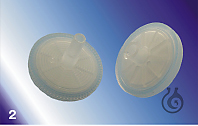 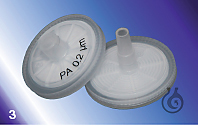 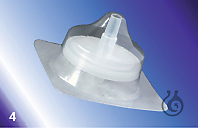 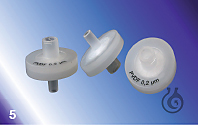 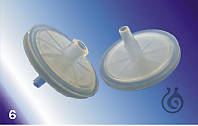 |
|||||||||||||||||||||||||||||||||||||||||||||||||||||||||||||||||||||||||||||||||||||||||||||||||||||||||||||||||||||||||||||||||||||||||||||||||||||||||||||||||||||||||||||||||||||||||||||||||||||||||||||||||||||||||||||||||||||||||||||||||||||||||||||||||||||||||||||||||||||||||||||||||||||||||||||||||||||||||||||||||||||||||||||||||||||||||||||||||||||||||||||||||||||||||||||||||||||||||||||||||||||||||||||||||||||||||||